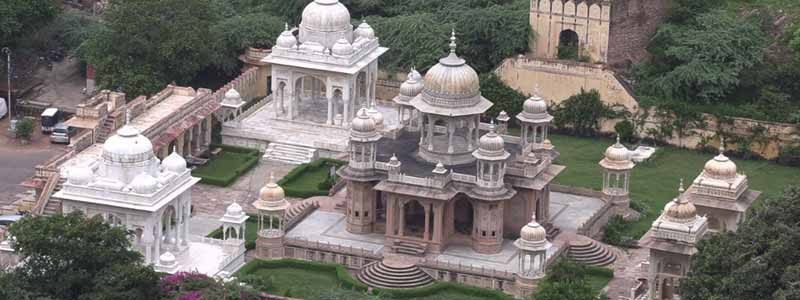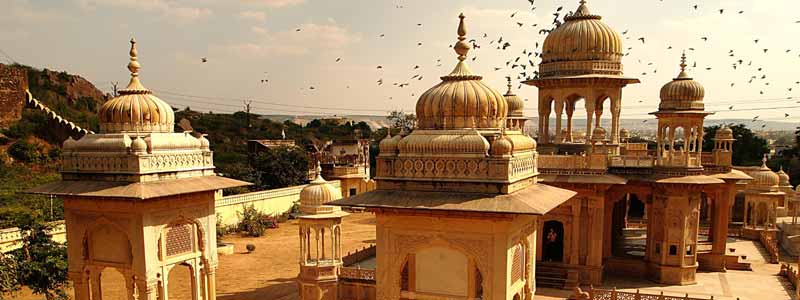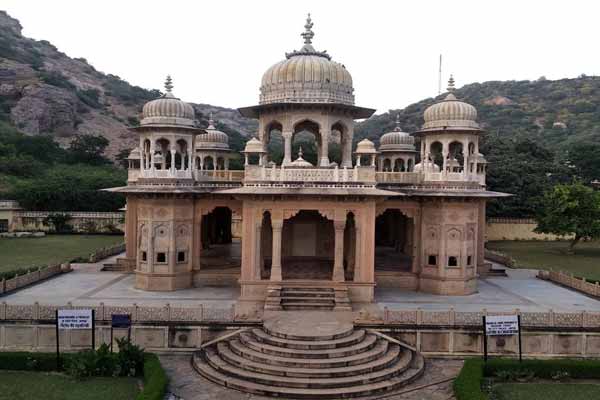Gatore Ki Chhatriyan Jaipur is the royal crematorium grounds for the Kachwaha, a Rajput clan that ruled in the region. The site was designated by the founder of Jaipur in the 18th century. The royals’ cenotaphs are scattered throughout the complex, creating what looks like a mix of shrunken open-air palaces and ornate towers. The structures mark the spots where former leaders were cremated.
They’re beautiful pieces of architecture to behold. Each is topped with an umbrella-shaped dome called a Gatore Ki Chhatriyan Jaipur, which is a common fixture in Indian memorials or cremation sites. The most impressive structures are made of marble while others were constructed with sandstone. Some are embellished with intricate carvings of elephants, battle scenes, and nature.
Gatore Ki Chhatriyan Jaipur is a fascinating hidden gem. You can take your time while soaking in the quiet atmosphere, though do be respectful and bear in mind the site’s funerary past Jaipur Tour Packages.

History
Gatore Ki Chhatriyan Jaipur, the royal cremation ground of the Kachhwaha Rajputs, was chosen as the designated place by Maharaja Sawai Jai Singh II, the founder of Jaipur, after he shifted the capital to the city. From 1733, the cremation of every Kachhwaha king was done here. The only cenotaph which is missing from here is the one of Maharaja Sawai Ishwari Singh whose cremation was done in the city palace complex in Jaipur.

Architecture
The cenotaphs of Gaitore symbolise the perfect blending of Islamic architecture and Hindu temple architecture. These are open domed pavilions which are built on a raised platform. Among the various cenotaphs dedicated to Sawai Ram Singh, Sawai Madho Singh and Maharaja Sawai Jai Singh II, the one which is dedicated to Maharaja Sawai Jai Singh II stands out. This cenotaph, made of pure white marble, Gatore Ki Chhatriyan Jaipur is decorated with stunning peacock deigns and patterns. The carvings in each cenotaph reflect the style and taste of the specific king and the culture which was prevalent in his time. Traces of paintings which once decorated the walls of the cenotaphs can still be seen Jaipur Attractions.
Entry Fee and Timings of Gatore Ki Chhatriyan Jaipur
The Gatore Ki Chhatriyan Jaipur is open from 9:30 a.m. to 5:00 p.m. every day. The ticket window closes by 4:30 p.m.
The entry charge for Gatore is Rs 30 per person. It is part of the composite City Palace Ticket, which costs Rs 300 per person for Indians and includes entry to Jaipur City Palace, Jaigarh Fort, Gatore, and Maharani Ki Chhatriyan on Amer Road.
Best Time to visit
Best time to visit Gatore Ki Chhatriyan Jaipur is between in the month of October to March. The weather is good in these month.
How to Reach
It is 16 km away from Jaipur. Local taxis and other means of public transport are easily available. You can also use private vehicles to travel to Gatore Ki Chhatriyan Jaipur. It is 7 km from Jaipur railway station and 14 km from Jaipur airport.
